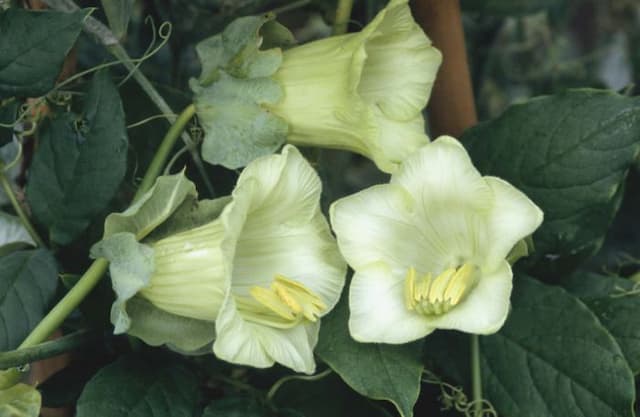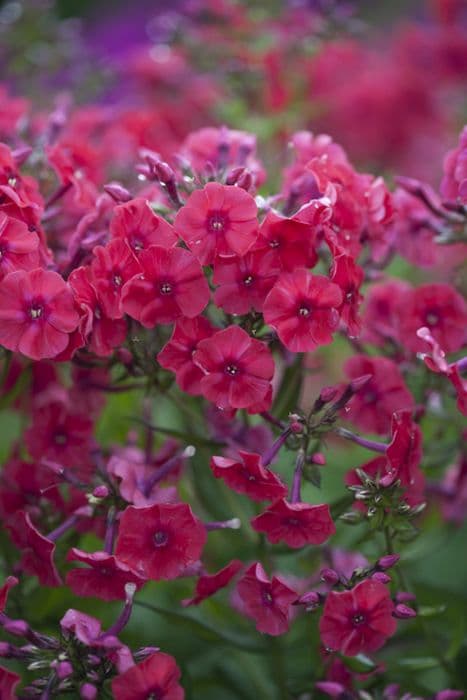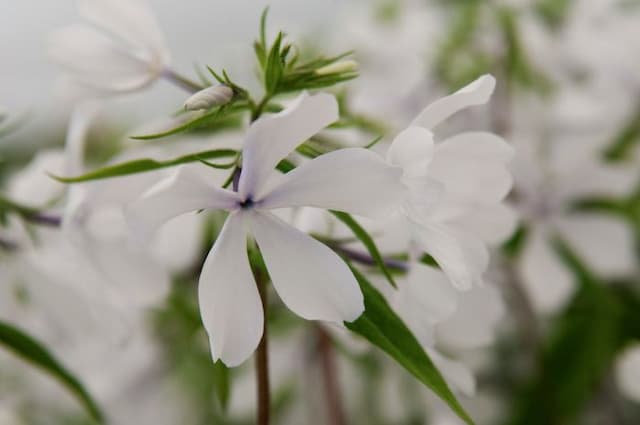Garden Phlox Phlox paniculata 'Grey Lady'

ABOUT
The Phlox paniculata 'Grey Lady' is recognized for its unique and attractive flowers. The blooms display a soothing shade, usually a pale lavender or a ghostly gray, providing an ethereal quality to gardens. The petals are delicate and lightly fragrant, arranged in clusters that make a striking visual impact. These flower clusters sit atop strong stems with lush green leaves that frame the floral display beautifully. The leaves are lance-shaped and provide a deep green contrast to the lighter colored flowers, making the blooms stand out even more. The plant's overall shape is somewhat bushy with a tendency to grow upright, creating a nice backdrop for shorter plants in a garden layout. Its blooms are popular with butterflies and hummingbirds, adding an extra layer of liveliness to its presence in a garden.
About this plant
 Names
NamesFamily
Polemoniaceae.
Synonyms
Garden Phlox, Summer Phlox, Fall Phlox, Perennial Phlox, Panicled Phlox.
Common names
Phlox paniculata
 Toxicity
ToxicityTo humans
Garden Phlox is not known to be toxic to humans. While it's generally not considered edible and therefore not recommended for ingestion, accidental consumption is unlikely to cause harm beyond possible mild gastrointestinal discomfort.
To pets
Garden Phlox is also not known to be toxic to pets. It is not listed among plants that are poisonous to cats, dogs, or other domestic animals. If a pet ingests a small quantity, it's unlikely to experience significant symptoms. However, as with the ingestion of any non-food plant material by animals, some gastrointestinal upset, such as vomiting or diarrhea, is possible.
 Characteristics
CharacteristicsLife cycle
Perennials
Foliage type
Deciduous
Color of leaves
Green
Flower color
Lavender
Height
2-3 feet (0.6-0.9 meters)
Spread
1-2 feet (0.3-0.6 meters)
Plant type
Herb
Hardiness zones
4
Native area
North America
Benefits
 General Benefits
General Benefits- Attracts Pollinators: Garden phlox is known for attracting bees, butterflies, and other beneficial insects, which assist in pollination of garden plants and flowers.
- Color and Fragrance: Offers bright, lavender-colored flowers and a pleasant fragrance that can enhance any garden or landscape setting.
- Long Blooming Period: Typically has a long blooming period from mid-summer to early fall, providing extended visual interest.
- Versatility: Suitable for borders, flowerbeds, and as background plants, fitting well into a variety of garden designs.
- Easy to Grow: Generally easy to care for and does not require complex maintenance, making it accessible for gardeners of varying experience levels.
- Drought Tolerance: Once established, it has good drought tolerance, decreasing the need for frequent watering.
- Cut Flowers: The stems and blooms are suitable for making lovely cut flower arrangements for indoor enjoyment.
- Plays a Role in Ecosystem: Garden phlox supports local ecosystems by providing nectar and habitat to wildlife.
 Medical Properties
Medical PropertiesThis plant is not used for medical purposes.
 Air-purifying Qualities
Air-purifying QualitiesThis plant is not specifically known for air purifying qualities.
 Other Uses
Other Uses- Garden borders enhancement: With its tall, elegant stems and clusters of lavender-colored flowers, Phlox can be used to add height and color to garden borders.
- Attracting pollinators: Phlox paniculata 'Grey Lady' is effective for attracting bees, butterflies, and other beneficial insects to the garden for pollination.
- Photography backdrop: The striking blooms of Phlox can serve as an excellent background for outdoor portrait photography.
- Companion planting: Phlox can be paired with other perennials to extend the flowering season and fill out planting arrangements in garden designs.
- Pressing flowers: The vibrant flowers are suitable for pressing and using in craft projects such as creating bookmarks, cards, or framed botanical art.
- Living mulch: When planted densely, Phlox can act as a living mulch, suppressing weeds and retaining soil moisture.
- Educational use: Phlox can be utilized in educational settings to teach about plant growth, pollination, and the importance of biodiversity in gardens.
- Dried flower arrangements: Phlox flowers, when dried, retain much of their color and can be used in dried floral arrangements or wreaths.
- Color theming: Due to their lavender hue, these plants can be used to create a color-themed garden section, such as a 'purple garden' or 'cool colors' border.
- Culinary decoration: Although not for consumption, the blooms can be used as non-toxic decorative garnishes for plating and presenting dishes.
Interesting Facts
 Feng Shui
Feng ShuiThe Garden Phlox is not used in Feng Shui practice.
 Zodiac Sign Compitability
Zodiac Sign CompitabilityThe Garden Phlox is not used in astrology practice.
 Plant Symbolism
Plant Symbolism- Agreement: The name "phlox" comes from the Greek word for "flame," symbolizing a strong agreement or unity, much like a flame that brings people together around a campfire.
- Sweet Dreams: In the language of flowers, phlox is associated with sweet dreams and sometimes used in bouquets meant to convey this sentiment.
- Harmony: The plant is often associated with harmony, due to its clusters of flowers that coexist beautifully on a single stem.
- Proposal of Love: Phlox, particularly in Victorian times, could symbolize a proposal or offer of love from one person to another.
 Water
WaterGarden Phlox should be watered deeply and thoroughly, with the aim to keep the soil evenly moist without it becoming waterlogged. It is best to water the plant early in the morning and direct water to the base to avoid wetting the foliage, which can lead to fungal diseases. The frequency of watering will vary with weather conditions, but generally, an inch of water per week is sufficient. During dry spells or hot weather, you may need to water twice a week, ensuring that the total amount equals about an inch of water. Monitor the soil moisture level between waterings to prevent overwatering or underwatering.
 Light
LightGarden Phlox thrives in full sun to partial shade. The ideal spot for this plant is an area that receives at least six hours of direct sunlight a day, which promotes strong growth and a profusion of blooms. However, in particularly hot climates, some afternoon shade helps to protect the plant from intense heat and avoid scorching of the leaves.
 Temperature
TemperatureGarden Phlox prefers temperatures ranging between 60°F and 85°F for optimal growth. It can tolerate a minimum temperature down to about -30°F once established, however, prolonged exposure to temperatures below 40°F is not ideal and should be avoided. The ideal temperature range allows for healthy foliage and vibrant flowers.
 Pruning
PruningPruning Garden Phlox is important to promote vigorous growth and prevent diseases. Deadheading the spent flowers will encourage a second bloom. Cut back the stems by one-third to one-half after the first major bloom to rejuvenate the plant. Pruning is best done in late winter or early spring before new growth begins.
 Cleaning
CleaningAs needed
 Soil
SoilGarden Phlox thrives in soil that is rich in organic matter, moist, and well-draining with a slightly acidic to neutral pH of 6.5 to 7.0. The best soil mix for Garden Phlox would include a blend of loam, compost, and perlite or sand to improve drainage.
 Repotting
RepottingGarden Phlox, being a perennial plant, does not typically require frequent repotting. Repot or divide the plant every few years in spring to maintain vigor and to control its spread within the garden.
 Humidity & Misting
Humidity & MistingGarden Phlox prefers moderate humidity levels but is quite adaptable to the typical humidity found in most garden environments. It does not have specific humidity requirements but should not be in overly dry air.
 Suitable locations
Suitable locationsIndoor
Ensure bright light, well-drained soil, and ample airflow for indoor Garden Phlox.
Outdoor
Full sun, well-drained soil, periodic watering for outdoor Garden Phlox.
Hardiness zone
4-8 USDA
 Life cycle
Life cycleGarden Phlox 'Grey Lady' begins its life as a seed, which when sown into fertile, well-drained soil in early spring after the last frost germinates into a small seedling. As temperatures warm, the seedling establishes a root system and grows into a vegetative state with stems and leaves through spring and early summer, experiencing vegetative growth that's facilitated by full sun and regular watering. In mid to late summer, it enters the flowering stage, producing clusters of pale lavender to white blossoms that attract pollinators like butterflies and hummingbirds to the garden. Post pollination, if conditions permit, seeds may develop in seed pods which can be dispersed by wind or animals once mature, typically in late summer to fall. As a perennial, after the flowering period and seed set, Phlox paniculata 'Grey Lady' enters a period of senescence in the fall where above-ground growth dies back with the onset of cooler temperatures and the plant goes dormant over winter, relying on its root system to survive until the next spring. This cycle repeats annually, with the plant potentially expanding its growth and floral display each year through spreading roots or self-seeding.
 Propogation
PropogationPropogation time
Spring-Early Summer
Propogation: The garden phlox, specifically the Phlox paniculata 'Grey Lady', can be propagated through several methods, but the most popular one is by division. Division is best done in early spring or late summer and is a fairly straightforward process. To propagate by division, dig up an established clump of phlox after the plant has finished blooming or before new growth starts. Carefully separate the plant into smaller sections, ensuring that each section has a good amount of roots and at least a few shoots. Plant these divisions immediately into a well-prepared garden bed or into pots if you plan to move them later, maintaining the same soil depth as they were previously. Water the new divisions thoroughly to help establish them, and maintain even moisture until the plants are well-rooted and show signs of new growth.









